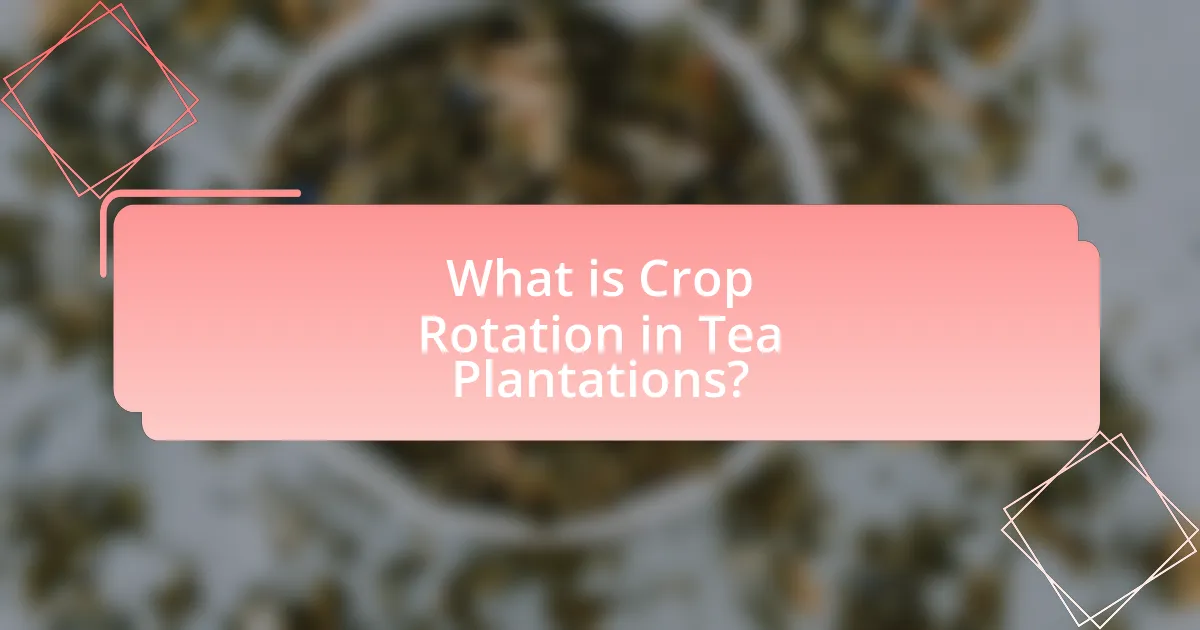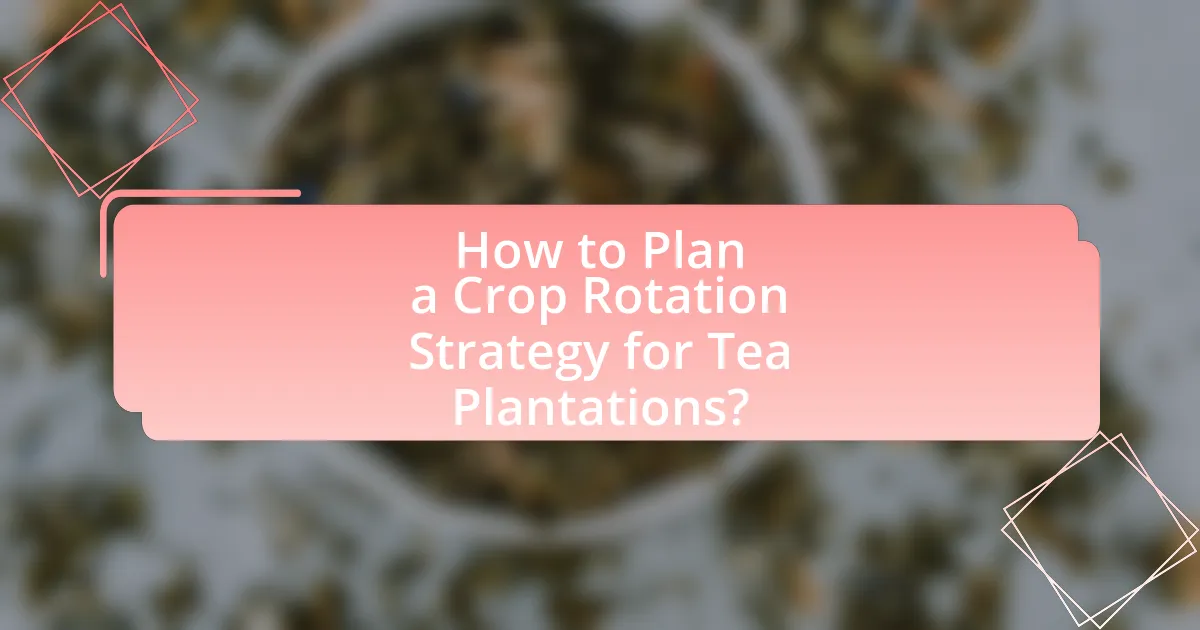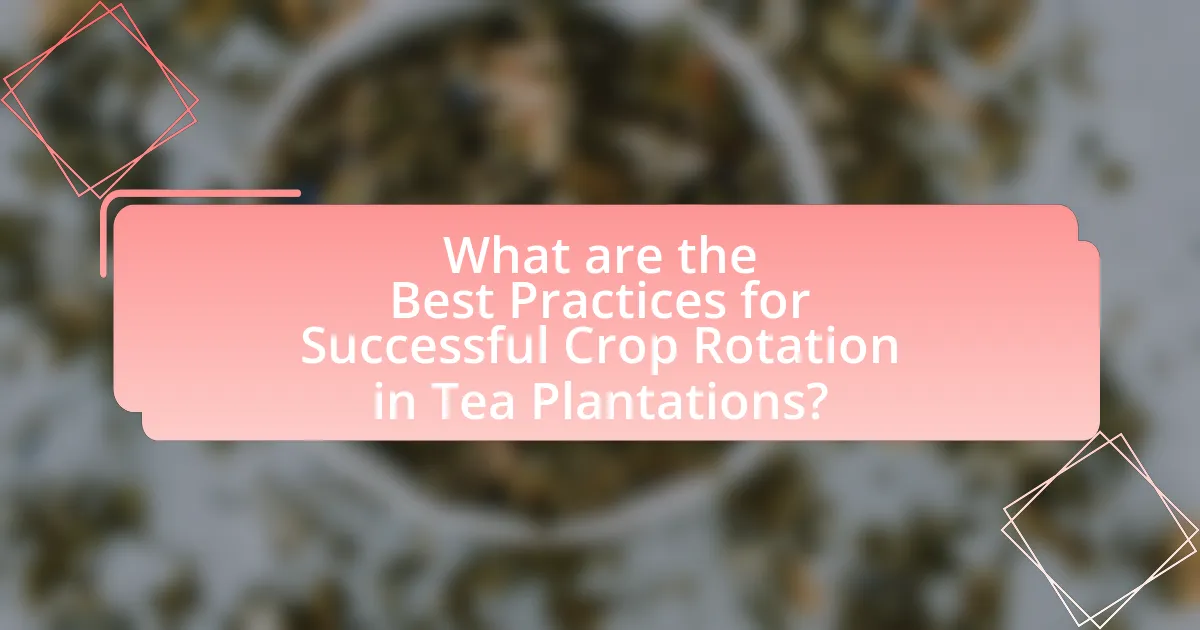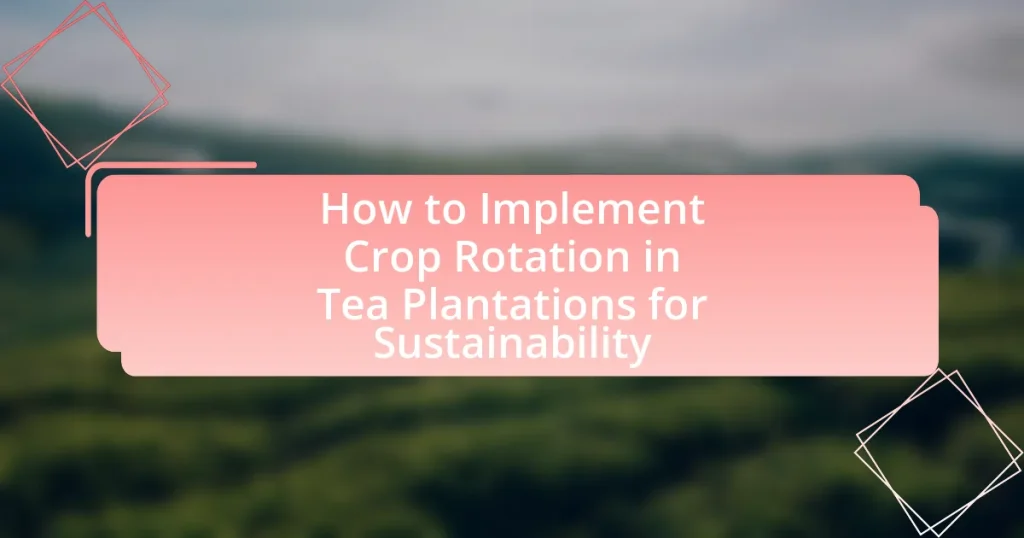Crop rotation in tea plantations is an agricultural practice that involves alternating the cultivation of tea with various crops to enhance soil fertility, reduce pest and disease prevalence, and improve overall crop yield. This method contributes to sustainability by promoting soil health, increasing nitrogen levels through legumes, and minimizing the need for chemical pesticides. Key principles of sustainable agriculture in tea cultivation include soil health management, biodiversity enhancement, and efficient water use. The article outlines the benefits of crop rotation, challenges faced in its implementation, and best practices for planning and executing effective crop rotation strategies in tea plantations. Additionally, it discusses the role of technology and local agricultural expertise in optimizing crop rotation for improved sustainability and productivity.

What is Crop Rotation in Tea Plantations?
Crop rotation in tea plantations is the agricultural practice of alternating the cultivation of tea with different crops over specific periods. This method enhances soil fertility, reduces pest and disease prevalence, and improves overall crop yield. Research indicates that rotating tea with legumes can increase nitrogen levels in the soil, which is beneficial for tea plants. Additionally, studies have shown that crop rotation can lead to a 20-30% increase in tea yield due to improved soil health and reduced competition from weeds.
How does crop rotation contribute to sustainability in tea cultivation?
Crop rotation enhances sustainability in tea cultivation by improving soil health and reducing pest and disease pressure. By alternating tea plants with other crops, nutrients are replenished, leading to better soil structure and fertility. For instance, legumes can fix nitrogen in the soil, which benefits subsequent tea crops. Additionally, crop rotation disrupts the life cycles of pests and diseases specific to tea, thereby minimizing the need for chemical pesticides. Research indicates that implementing crop rotation can increase yields by up to 20% while promoting biodiversity and ecological balance in tea plantations.
What are the key principles of sustainable agriculture in tea plantations?
The key principles of sustainable agriculture in tea plantations include soil health management, biodiversity enhancement, efficient water use, integrated pest management, and social equity. Soil health management focuses on maintaining soil fertility through organic amendments and reduced chemical inputs, which supports plant growth and ecosystem balance. Biodiversity enhancement involves cultivating a variety of plants and maintaining natural habitats to promote beneficial organisms and reduce pest outbreaks. Efficient water use emphasizes practices such as rainwater harvesting and drip irrigation to conserve water resources. Integrated pest management combines biological, cultural, and chemical methods to control pests sustainably while minimizing environmental impact. Lastly, social equity ensures fair labor practices and community engagement, contributing to the overall sustainability of tea production. These principles collectively support the long-term viability of tea plantations while addressing environmental and social challenges.
How does crop rotation enhance soil health in tea plantations?
Crop rotation enhances soil health in tea plantations by improving soil structure, increasing nutrient availability, and reducing pest and disease pressure. By alternating tea with legumes or other crops, the soil benefits from enhanced nitrogen fixation, which enriches nutrient content. Additionally, diverse root systems from different crops improve soil aeration and water retention, leading to better overall soil structure. Research indicates that crop rotation can reduce the incidence of soil-borne diseases, thereby promoting healthier tea plants and higher yields.
Why is crop rotation important for tea plantations?
Crop rotation is important for tea plantations because it enhances soil fertility and reduces pest and disease pressure. By alternating tea with other crops, nutrients are replenished, and the risk of soil degradation is minimized. Research indicates that rotating tea with legumes can increase nitrogen levels in the soil, which is essential for tea plant growth. Additionally, crop rotation disrupts the life cycles of pests and diseases specific to tea, leading to healthier plants and potentially higher yields.
What are the environmental benefits of implementing crop rotation?
Implementing crop rotation provides significant environmental benefits, including improved soil health, reduced pest and disease pressure, and enhanced biodiversity. Crop rotation enhances soil structure and fertility by alternating deep-rooted and shallow-rooted plants, which helps in nutrient cycling and prevents soil erosion. Research indicates that rotating crops can reduce the need for chemical fertilizers by up to 30%, as different plants contribute various nutrients to the soil. Additionally, rotating crops disrupt the life cycles of pests and diseases, leading to lower pesticide use and promoting a healthier ecosystem. Studies have shown that diverse cropping systems can increase the abundance of beneficial insects, thereby supporting natural pest control and enhancing overall biodiversity in agricultural landscapes.
How does crop rotation affect pest and disease management in tea?
Crop rotation significantly enhances pest and disease management in tea by disrupting the life cycles of pests and pathogens. By alternating tea with other crops, the availability of specific host plants for pests is reduced, leading to lower pest populations. For instance, studies have shown that rotating tea with legumes can decrease the incidence of root diseases caused by pathogens like Fusarium, as these legumes do not support the same pathogens that affect tea. Additionally, crop rotation can improve soil health and biodiversity, which further contributes to a more resilient ecosystem that naturally suppresses pest outbreaks.
What challenges are associated with implementing crop rotation in tea plantations?
Implementing crop rotation in tea plantations faces several challenges, including soil compatibility, pest management, and economic viability. Soil compatibility issues arise because tea plants have specific nutrient requirements, and introducing other crops may disrupt the nutrient balance. Pest management becomes complex as different crops can attract various pests, complicating control measures. Economic viability is a significant concern, as farmers may face initial costs for transitioning to crop rotation and uncertainty about market demand for the new crops. These challenges necessitate careful planning and research to ensure successful implementation.
What are the common misconceptions about crop rotation in tea cultivation?
Common misconceptions about crop rotation in tea cultivation include the belief that it is unnecessary due to tea’s perennial nature and that it complicates management practices. Many assume that tea plants do not benefit from crop rotation because they are not annual crops; however, rotating tea with legumes or cover crops can enhance soil fertility and reduce pest pressures. Additionally, some growers think that implementing crop rotation requires extensive changes to existing practices, but it can be integrated gradually and tailored to specific plantation conditions, making it a feasible strategy for improving sustainability in tea cultivation.
How can farmers overcome the challenges of crop rotation?
Farmers can overcome the challenges of crop rotation by implementing strategic planning and utilizing cover crops. Strategic planning involves selecting appropriate crop sequences that enhance soil health and reduce pest pressures, which is essential for maintaining productivity in tea plantations. Utilizing cover crops, such as legumes, can improve soil nitrogen levels and prevent erosion, thereby supporting the main crops during their growth cycles. Research indicates that effective crop rotation can lead to a 20-30% increase in yield over time by improving soil structure and fertility, as demonstrated in various agricultural studies.

How to Plan a Crop Rotation Strategy for Tea Plantations?
To plan a crop rotation strategy for tea plantations, first identify the specific crops that can be rotated with tea, such as legumes, which enhance soil fertility through nitrogen fixation. Implement a rotation schedule that allows for a minimum of three years between tea plantings to reduce pest and disease pressure, as supported by research indicating that diverse cropping systems can improve soil health and yield stability. Additionally, monitor soil nutrient levels and adjust the rotation plan based on soil health assessments to ensure optimal growth conditions for tea.
What factors should be considered when designing a crop rotation plan?
When designing a crop rotation plan, factors such as soil health, pest and disease management, crop nutrient requirements, and climatic conditions must be considered. Soil health is crucial as rotating crops can improve soil structure and fertility, reducing erosion and enhancing microbial activity. Pest and disease management benefits from crop rotation by disrupting the life cycles of pests and pathogens, thereby reducing their populations. Different crops have varying nutrient requirements; thus, rotating them helps in balancing soil nutrient levels and preventing depletion. Finally, climatic conditions influence the selection of crops that can thrive in specific environments, ensuring optimal growth and yield.
How do climate and soil type influence crop rotation choices?
Climate and soil type significantly influence crop rotation choices by determining the suitability of specific crops for cultivation. For instance, warm climates with adequate rainfall favor crops like legumes and grains, while cooler climates may support root vegetables and brassicas. Soil type affects nutrient availability and drainage; sandy soils drain quickly and may require more frequent crop rotations to maintain fertility, whereas clay soils retain moisture but can lead to compaction issues if not rotated properly. Research indicates that diverse crop rotations can enhance soil health and reduce pest pressures, making them essential for sustainable practices in tea plantations.
What are the best companion crops for tea in a rotation system?
The best companion crops for tea in a rotation system include legumes such as cowpeas and mung beans, as well as crops like maize and sweet potatoes. Legumes enhance soil fertility through nitrogen fixation, which benefits tea plants. Maize and sweet potatoes can provide ground cover, reducing weed competition and improving soil structure. Research indicates that incorporating these companion crops can lead to increased yields and improved soil health in tea plantations, supporting sustainable agricultural practices.
How can farmers implement crop rotation effectively?
Farmers can implement crop rotation effectively by planning a systematic sequence of different crops over time to enhance soil health and reduce pest and disease pressure. This involves selecting crops that have varying nutrient requirements and growth habits, such as alternating deep-rooted and shallow-rooted plants, which can improve soil structure and nutrient availability. Research indicates that rotating crops can lead to a 10-20% increase in yield due to improved soil fertility and reduced reliance on chemical fertilizers. Additionally, farmers should monitor soil health and pest populations to adjust their rotation plans accordingly, ensuring that the chosen crops complement each other and contribute to sustainable agricultural practices.
What steps should be taken to prepare for crop rotation in tea plantations?
To prepare for crop rotation in tea plantations, the first step is to assess the current soil health and nutrient levels through soil testing. This analysis helps determine the specific nutrient deficiencies and pH levels, which are crucial for selecting appropriate cover crops and rotation partners. Following the soil assessment, farmers should select compatible crops that can improve soil fertility and disrupt pest cycles, such as legumes or other nitrogen-fixing plants.
Next, a detailed planting schedule should be developed, outlining the timing for planting and harvesting each crop to ensure optimal growth and minimize competition. Additionally, farmers should implement proper land preparation techniques, including tillage and mulching, to enhance soil structure and moisture retention.
Finally, monitoring and adjusting the crop rotation plan based on observed outcomes and soil health improvements is essential for long-term sustainability. Research indicates that effective crop rotation can lead to increased yields and reduced pest pressures, supporting the overall health of tea plantations.
How can technology assist in managing crop rotation schedules?
Technology assists in managing crop rotation schedules by utilizing data analytics, precision agriculture tools, and automated systems. These technologies enable farmers to analyze soil health, weather patterns, and crop performance, allowing for informed decisions on which crops to plant and when. For instance, software applications can track crop history and suggest optimal rotation sequences based on agronomic data, enhancing soil fertility and pest management. Research indicates that farms employing precision agriculture techniques can increase yields by up to 20% while reducing input costs, demonstrating the effectiveness of technology in optimizing crop rotation practices.

What are the Best Practices for Successful Crop Rotation in Tea Plantations?
The best practices for successful crop rotation in tea plantations include selecting compatible crops, maintaining soil health, and timing the rotation effectively. Compatible crops, such as legumes, can enhance soil nitrogen levels, benefiting tea plants. Maintaining soil health involves incorporating organic matter and practicing minimal tillage to prevent soil degradation. Effective timing ensures that crops are rotated during appropriate seasons to optimize growth and minimize pest and disease cycles. Research indicates that these practices can lead to improved yields and sustainability in tea cultivation, as evidenced by studies showing increased soil fertility and reduced pest incidence in rotated systems.
How can farmers monitor the effectiveness of their crop rotation?
Farmers can monitor the effectiveness of their crop rotation by analyzing soil health, crop yields, and pest populations. Soil tests can reveal nutrient levels and microbial activity, indicating how well the rotation is improving soil fertility. Additionally, tracking crop yields over multiple seasons allows farmers to assess productivity changes linked to different crop sequences. Monitoring pest populations helps identify whether crop rotation is effectively disrupting pest life cycles, reducing infestations. Research shows that diverse crop rotations can lead to a 10-20% increase in yields and a significant reduction in pest pressure, validating these monitoring methods.
What indicators should be tracked to assess soil health and crop yield?
To assess soil health and crop yield, key indicators include soil organic matter, pH levels, nutrient availability, microbial activity, and soil structure. Soil organic matter is crucial as it enhances nutrient retention and water holding capacity, directly influencing crop productivity. pH levels affect nutrient availability; for instance, a pH between 6.0 and 7.5 is generally optimal for most crops. Nutrient availability, particularly nitrogen, phosphorus, and potassium, is essential for healthy plant growth. Microbial activity indicates soil biological health, as diverse microbial communities contribute to nutrient cycling. Lastly, soil structure impacts root penetration and water infiltration, which are vital for crop development. These indicators collectively provide a comprehensive understanding of soil health and its capacity to support crop yield.
How can feedback from crop performance inform future rotations?
Feedback from crop performance can inform future rotations by providing data on yield, pest resistance, and soil health, which helps in selecting the most suitable crops for subsequent planting. Analyzing past crop yields allows farmers to identify which crops thrive in specific conditions, enabling them to optimize rotation schedules for improved productivity. For instance, if a particular crop consistently shows high yields and low pest incidence, it may be prioritized in future rotations to enhance overall farm sustainability. Additionally, soil health indicators, such as nutrient levels and microbial activity, can guide decisions on crop diversity, ensuring that rotations contribute to soil fertility and ecosystem balance.
What tips can enhance the success of crop rotation in tea plantations?
To enhance the success of crop rotation in tea plantations, implement diverse crop selection, which improves soil health and pest management. Rotating tea with legumes, for example, can fix nitrogen in the soil, promoting nutrient availability for subsequent tea crops. Additionally, maintaining proper timing in planting and harvesting ensures that crops do not compete for resources, optimizing growth conditions. Research indicates that integrating cover crops can prevent soil erosion and improve moisture retention, further supporting tea plant health. Regular soil testing is also crucial, as it provides data on nutrient levels and informs crop choices, ensuring that the rotation system remains effective over time.
How can farmers engage with local agricultural experts for better crop rotation strategies?
Farmers can engage with local agricultural experts for better crop rotation strategies by participating in workshops and extension programs offered by agricultural universities or government agencies. These programs often provide tailored advice based on local soil conditions, climate, and crop types, which is essential for effective crop rotation. For instance, the University of California Cooperative Extension provides resources and expert consultations that help farmers optimize their crop rotation plans, leading to improved soil health and increased yields. Additionally, farmers can establish direct communication with local agronomists or agricultural consultants who can offer personalized recommendations and ongoing support.
What resources are available for farmers looking to implement crop rotation?
Farmers looking to implement crop rotation can access various resources, including agricultural extension services, university research programs, and online platforms dedicated to sustainable farming practices. Agricultural extension services provide localized advice and support tailored to specific regions, while university research programs often publish studies and guidelines on effective crop rotation strategies. Online platforms, such as the Sustainable Agriculture Research and Education (SARE) program, offer comprehensive resources, including case studies, best practices, and tools for planning crop rotations. These resources collectively enhance farmers’ understanding and implementation of crop rotation, contributing to sustainable agricultural practices.


